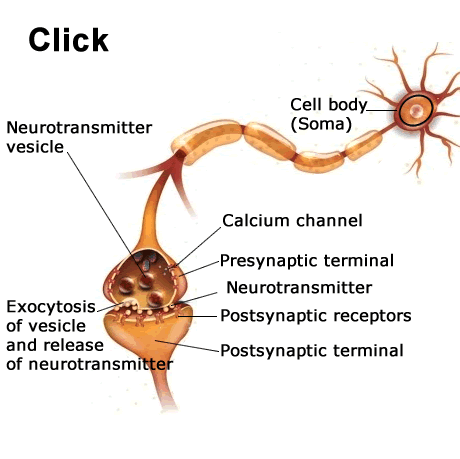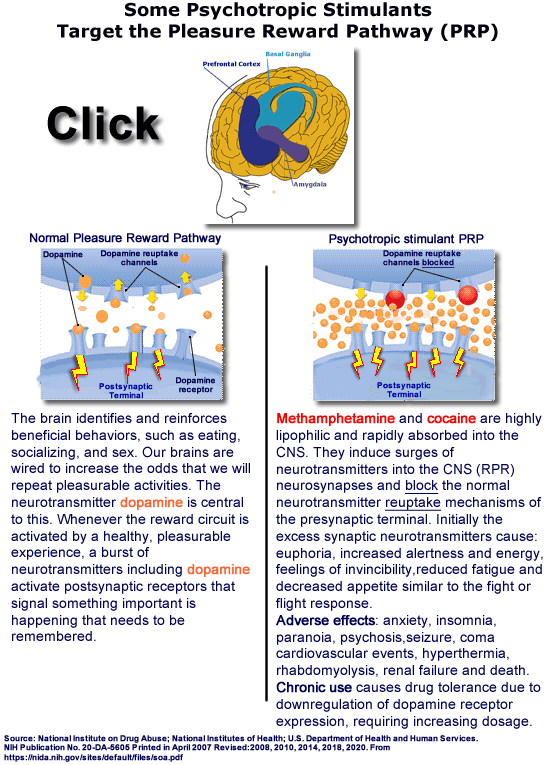Physiology of Drug Abuse
 Drugs interfere with how neurons send, receive, and process signals via neurotransmitters. Some drugs, such as marijuana and heroin, can activate neurons because their chemical structure mimics a natural neurotransmitter in the body allowing the drugs to attach and activate the neurons. Although these drugs mimic the brain’s chemicals, they don’t activate neurons in the same way as a natural neurotransmitter, leading to abnormal messages being sent through the network (NIDA 2022). Drugs, such as amphetamine or cocaine, can cause the neurons to release abnormally large amounts of natural neurotransmitters or prevent the normal recycling of these brain chemicals by interfering with transporters and amplifying or disrupting the communication between neurons (NIDA 2022).
Drugs interfere with how neurons send, receive, and process signals via neurotransmitters. Some drugs, such as marijuana and heroin, can activate neurons because their chemical structure mimics a natural neurotransmitter in the body allowing the drugs to attach and activate the neurons. Although these drugs mimic the brain’s chemicals, they don’t activate neurons in the same way as a natural neurotransmitter, leading to abnormal messages being sent through the network (NIDA 2022). Drugs, such as amphetamine or cocaine, can cause the neurons to release abnormally large amounts of natural neurotransmitters or prevent the normal recycling of these brain chemicals by interfering with transporters and amplifying or disrupting the communication between neurons (NIDA 2022).
 Research into the causes and mechanisms of drug abuse have led scientists to conclude that distinct areas of the brain are involved in response to psychostimulant substances. Collectively, these areas are called the Pleasure Reward Pathway (PRP).
Research into the causes and mechanisms of drug abuse have led scientists to conclude that distinct areas of the brain are involved in response to psychostimulant substances. Collectively, these areas are called the Pleasure Reward Pathway (PRP).
The PRP includes the dopaminergic pathway from the prefrontal cortex, basal ganglia and amygdala. The neurotransmitter dopamine activates the dopaminergic pathways.
Most of the experimental data is derived from animal experimentation, during which electrodes were placed into the PRP of rats and monkeys. The animals were allowed to stimulate their PRP by pressing a switch bar. Bar pressing soon occupied most of the animal's time. Many animals were seen to forego food and water in preference to autostimulation. The autostimulation in many instances continued to exhaustion. Some monkeys were clocked at 17,000 bar presses per hour.
A number of PRP autostimulation experiments have been done on humans. Many participants described a "quiet relaxed feeling" or "relief of tension." However, those participants with the highest autostimulation rates could not explain why they continued to bar press. From these and other experiments, scientists theorize that the PRP functions as a "motivator" through which the organism is reward. The "motivator" function is important to organisms that must actively engage their environment to find new sources of food, shelter, mates etc.
The primary effect of stimulation of the PRP is an increased synaptic concentration of the neurotransmitter dopamine. Many commonly abused drugs increase the synaptic concentration of dopamine within the PRP. Of these, opiates, cocaine, amphetamine, ethyl alcohol and nicotine have been most studied. Each of theses drugs work differently but all have the effect of increasing the amount of dopamine available for binding with dopamine receptors.
Instant Feedback:
Drugs, such as methamphetamine and cocaine, can cause the neurons to release abnormally large amounts of natural neurotransmitters or prevent the normal recycling of these brain chemicals by interfering with transporters and amplifying or disrupting the communication between neurons.
References
NIDA. 2022, March 22. Drugs and the Brain. Retrieved from https://nida.nih.gov/publications/drugs-brains-behavior-science-addiction/drugs-brain on 2023, September 12
©RnCeus.com
 Drugs interfere with how neurons send, receive, and process signals via neurotransmitters. Some drugs, such as marijuana and heroin, can activate neurons because their chemical structure mimics a natural neurotransmitter in the body allowing the drugs to attach and activate the neurons. Although these drugs mimic the brain’s chemicals, they don’t activate neurons in the same way as a natural neurotransmitter, leading to abnormal messages being sent through the network (NIDA 2022). Drugs, such as amphetamine or cocaine, can cause the neurons to release abnormally large amounts of natural neurotransmitters or prevent the normal recycling of these brain chemicals by interfering with transporters and amplifying or disrupting the communication between neurons (NIDA 2022).
Drugs interfere with how neurons send, receive, and process signals via neurotransmitters. Some drugs, such as marijuana and heroin, can activate neurons because their chemical structure mimics a natural neurotransmitter in the body allowing the drugs to attach and activate the neurons. Although these drugs mimic the brain’s chemicals, they don’t activate neurons in the same way as a natural neurotransmitter, leading to abnormal messages being sent through the network (NIDA 2022). Drugs, such as amphetamine or cocaine, can cause the neurons to release abnormally large amounts of natural neurotransmitters or prevent the normal recycling of these brain chemicals by interfering with transporters and amplifying or disrupting the communication between neurons (NIDA 2022). Research into the causes and mechanisms of drug abuse have led scientists to conclude that distinct areas of the brain are involved in response to psychostimulant substances. Collectively, these areas are called the Pleasure Reward Pathway (PRP).
Research into the causes and mechanisms of drug abuse have led scientists to conclude that distinct areas of the brain are involved in response to psychostimulant substances. Collectively, these areas are called the Pleasure Reward Pathway (PRP).